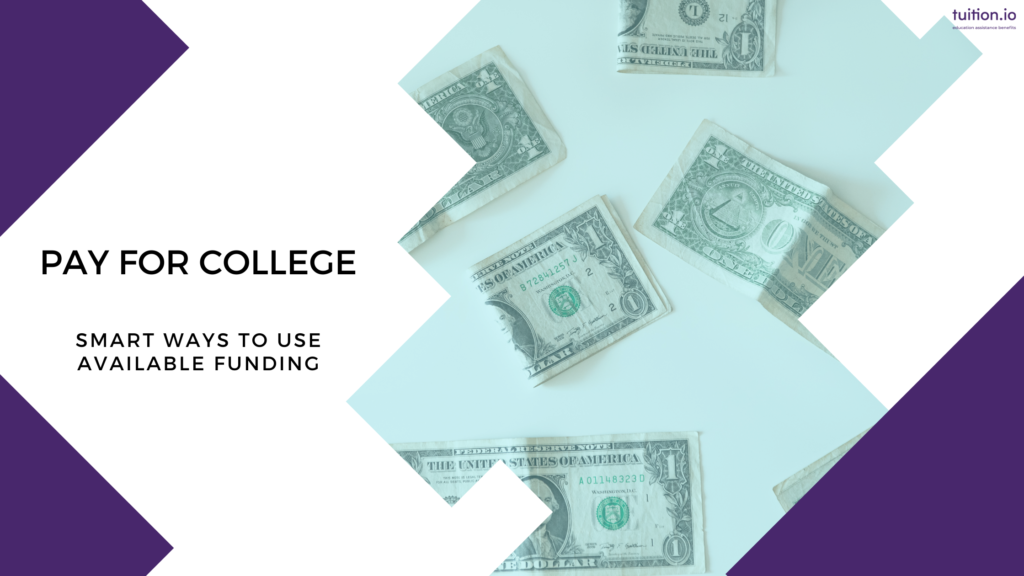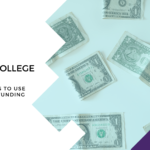From free money and savings to the dreaded student loan, figuring out the best way to fund a college education can be overwhelming. This post offers a high level overview of the options. You’ll also get tips on important dates for federal financial aid and find links to free scholarship search databases. Another important tip is using your funding in the right order to maximize your ability to pay for college. This post covers the best order to use college funding too.
What are the available options to pay for college?
Scholarships and Grants: Free money that doesn’t have to be repaid. There are federal grants, which tend to be based on financial need. You can also find scholarships from multiple sources like the college, private donors & foundations, and organizations.
Federal Student Aid: Many people think of federal aid as student loans. But there are actually three parts to federal student aid. The first part is federal grant money, the second is work study, and the third is student loans.
Personal & Family Savings: You or your family may set aside money for the specific purpose of paying for higher education. This can include savings accounts and tax-advantaged investment vehicles like 529 accounts.
Private Student Loans: You can think of private student loans as similar to other types of loans like auto loans or mortgages. That means they require credit history and don’t qualify for loan forgiveness or lenient repayment options.
Start with free money when trying to pay for college.
The very best way to pay for college is with someone else’s money that you don’t have to pay back. Scholarships and grants are typically not enough to cover all your costs, but even $1,000 you don’t have to pay back saves you money in accumulated interest and loan origination fees.
Work study is another way to help pay for college and tends to pay well for a college job, provides flexibility around class schedules, and provides work on campus. All these things are positives for individuals with limited transportation budget or resources. Some students are able to find better work off campus that pays more or gives them more targeted experience in their field so may choose to opt out of work study.
After free money it’s time to use dedicated savings.
Not all families have been able to save for a child’s college education. 529 funds can be used for eligible education-related costs, including tuition & fees, room & board, and even computers without penalty. Savings in a regular account are incredibly flexible and can be used for anything at anytime. Some people prefer to hold on to their cash savings for expenses that come up throughout college.
Use federal student loans in the right order to pay for college.
Once you’ve exhausted your free money and savings it’s likely you will need to take out loans to make up the financial shortfall. Use your loans from the lowest cost to borrow to the highest cost to borrow. Federal student loans have more generous protections and forgiveness options.
- Federal subsidized student loans: These are loans made by the Department of Education (DOE) where the government subsidizes the interest during school. That means borrowers don’t have interest added on to their loan burden while enrolled in classes at least half-time. There are limits on these loans and eligibility is based on some degree of financial need.
- Federal unsubsidized student loans: These are student loans made by the DOE but the government doesn’t subsidize the interest. That means these loans grow in balance as soon as they’re taken out. Anyone can access this type of loan, there are no income limits.
- Federal Parent PLUS loans: The DOE issues these loans to parents for a dependent’s education costs. Interest rates on Parent PLUS loans are higher than other types of federal student loans. These are the only student loans that require a credit check and no adverse credit history. Parent PLUS loans have less stringent credit criteria than private loans.
Private loans are a last resort for financial shortfall.
Private student loans typically have higher interest rates than federal loans. If you are a student without a credit history you will often need a co-signer to obtain private loans. Private loans aren’t eligible for loan forgiveness or likely any future actions to forgive student loan debt. Only take out the smallest amount you need to pay for college. Some parents may be able to get a lower interest rate on a private loan than they can for a federal Parent PLUS loan.
Fill out the FAFSA early and even if you make a lot of money.
You can fill out the FAFSA from Oct 1st – June 30th each year for the following fall semester. So if I wanted to go to college in August of 2021 I could have filled out the FAFSA as early as Oct 1st 2020. Don’t worry about needing recent taxes, you can use your 2019 tax return and contact schools specifically if your income changed significantly.
You can put up to 10 schools on the FAFSA so even if you’re not 100% sure where you’re going to attend school you can still submit the FAFSA. This will also let you see the financial offerings of each institution so you can compare costs to help you decide.
Filling out the FAFSA early gives you the best access to available grants and scholarships. Many institutions require FAFSA completion in order to award scholarships and grants. Free money like grants and scholarships tend to get awarded early so by submitting your FAFSA right away you have the best chance of accessing it.
Unsubsidized student loans don’t have income limits. So even if your family has a high income your child can still access unsubsidized student loans. FAFSA is often required at many schools, even for merit-based aid. So it’s worth your time and energy to complete this.
Additional Resources
FAFSA isn’t Spooky: Tips for Fearless Financial Aid
International Student Loans Lending and Repayment Options
Ask Jeni: Can I Transfer my Parent PLUS Loan to my Child?
Federal Student Aid Eligibility
Private student loan marketplace
Scholarship Search Databases
https://www.chegg.com/scholarships
https://www.careeronestop.org/toolkit/training/find-scholarships.aspx
https://bigfuture.collegeboard.org/scholarshipsearch#!personalinformation




